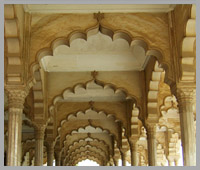
Agra Tourism Attractions
Agra Fort Buland Darwaza Chini - Ka - Rauza Dayal Bagh Temple Fatehpur Sikri Itmad-ud-daulah Mariyam Tomb Mumtaz Mahal Ram Bagh Shopping & Cuisine Sikandra The Taj Mahal Taj Mahotsav The Octagonal TowerAgra Fort

Agra Fort, The Red Fort, was built by Akbar in 1565. This is the red sandstone fort located about 2.5 km northwest of the Taj Mahal in Agra. The fort stands one of the most important forts in India, where the great Mughals emperor like Humayun, Akbar, Jehangir, Shah Jahan and Aurangzeb lived and governed their empire.
This large building is known for its particular design and decorations that please the tourists during their Agra Fort Tour. This fort is one of the crucial and robustly built strongholds of the Mughals. This is far-famed for its number of richly decorated buildings encompassing the imposing Mughal style of art and architecture. The fort spread over 94 sq. km and its semi-circular design is enclosed by a 21.4 m high fortification wall. Double bulwarks have been availed in the fort with wide massive circular bastions at daily intervals.
Truly this fort is among the finest examples of the Indo-Islamic architectural fusion. The fort may be accessed through four gates namely Delhi Gate, Lahore Gate and Amar Singh Gate. Today the entrance to the fort is only through the Amar Singh Gate.
Agra Fort is an astounding structure that comprises of sprawling palaces, royal private rooms, harems, splendid towers, bastions, ramparts, and impressive gateways.
Some of the well-known monumental structures of this fort are as:
Jahangir Mahal
This double-storied palace was built by Akbar as the royal women’s quartersand this is the only building that goes among the original palace buildings. The architectural design of this palace shows a Hindu influence with jutting balconies and domed chhatries. Jahangir Mahal is simple in its outlook and is built out of sandstone. The most important feature of this construction is its ornamental stone brackets that assist the beams. Jahangir has shaped ornamental Persian verses along the outer rim of this palace which increases its decorative beauty.
Diwan-e-Khas
Diwan-e-Khas is a Persian word which means ‘The Hall of Private Audience’. The hall was used for the private meetings by emperors. This building is renowned for its facades as well as intricate design. The marble pillars of this building are decorated with semi-precious stones in pleasing floral patterns. It was here the famous peacock throne was kept before being shifted to Delhi by Aurangzeb and finally took away to Iran.

Diwan-e-Aam
Divan-e-Aam was the ‘Hall of Public Audience’ constructed by Shahjahan. In this building, the Emperor used to meet officials and commoners and hear their petitions. This hall was pierced with Jallis to facilitate royal female members to see the court proceedings. The prominent structures of this building are arched covered with white lime polish, triple arched royal canopy, lavish pietra dura ornamentation and the splendid ‘Jaalis’ on the back wall of the pavilion.
Sheesh Mahal
Sheesh Mahal was used as the dressing room (harem). This palace is well-known for its walls inlaid with tiny mirrors that are the best examples of the glass-mosaic decoration in India. The beauty of innumerable glass pieces works and the central fountain please to tourists during their visit to this palace.
Khas Mahal
This palace was built of marble and demonstrates classifiable Islamic-Persian features of design & decorations. This was the Shah Jahan’s sleeping room. The Mahal avails the most successful example of paintings on a white marble surface.
Musamman Burj
Musamman Burj is a beautiful octagonal tower with an open pavilion famous for its exquisite design above the pillars.
Timings
6:00 am to 7:30 pm (Friday closed)
Fee
Rs. 970 (Foreigners)
Rs. 20 (Indians, during daytime)
Rs. 110 (Indians, during sunrise and sunset)
Home of the Mughal rulers to rule their kingdom.
